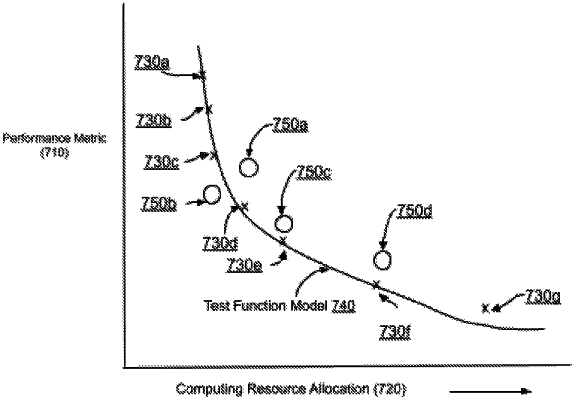| CPC G06F 9/5016 (2013.01) [G06F 8/71 (2013.01); G06F 9/5094 (2013.01); G06F 11/079 (2013.01); G06F 11/0721 (2013.01); G06F 11/0769 (2013.01); G06F 11/3006 (2013.01); G06F 11/34 (2013.01); G06F 11/3452 (2013.01); G06N 3/08 (2013.01); G08B 21/182 (2013.01); H04L 43/16 (2013.01); H04L 67/10 (2013.01); H04L 67/34 (2013.01); G06F 2209/501 (2013.01)] | 20 Claims |

|
1. A method to manage a computing resource for a distributed computing system, comprising:
executing a first test function using the distributed computing system at a first plurality of allocation setpoints for the computing resource;
based on the execution, obtaining one or more performance metrics for the first test function for each setpoint of the first plurality of allocation setpoints;
training a machine learning model based on the obtained one or more performance metrics, wherein training the machine learning model comprises fitting a function to each of the obtained performance metrics over the first plurality of allocation setpoints;
utilizing the trained machine learning model to manage the computing resource for a second function, wherein utilizing the trained machine learning model to manage the computing resource for the second function comprises:
receiving the second function to be optimized for the computing system;
executing the second function at a second plurality of allocation setpoints for the computing resource, wherein the second plurality of allocation setpoints comprises a fewer number of setpoints compared to the first plurality of allocation setpoints;
obtaining the one or more performance metrics for the second function for each of the second plurality of allocation setpoints;
applying the trained machine learning model to the obtained performance metrics for the second function for each of the second plurality of allocation setpoints;
determining an optimal allocation setpoint for the one or more performance metrics based on the trained machine learning model; and
providing a recommendation of a setpoint for the computing resource for the second function based on the determined optimal allocation setpoint.
|